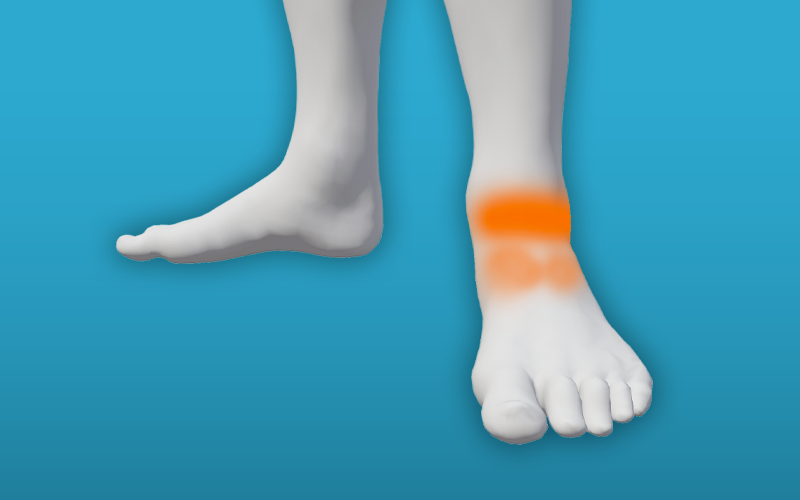
Osteoarthritis of the ankle
What is it?
Osteoarthritis is a wear and repair process and can affect the ankle, however, this is less common than other joints. It is often related to a previous trauma to the joint. It can lead to joint pain with limitation of movement, this can affect daily activities. Osteoarthritis is the most common type of arthritis, affecting approximately 9 million people in the UK.
Versus Arthritis have produced a summary of ‘What is osteoarthritis?’ which you can watch in the video below.
In osteoarthritis we see changes to the cartilage of the joint as well as other secondary changes such as inflammation. Cartilage helps our joints move freely. Changes to the cartilage can lead to pain, stiffness, and loss of movement. This can in time lead to weakness around the muscles of the joint.
It most commonly affects people older than 45 and is more common if have a family history of it, overweight or have previously injured the joint in question. Osteoarthritis has varying degrees on functional limitation and effect on quality of life. Contrary to popular belief does not affect everyone as you get older and does not necessarily get worse.
What are the common symptoms of osteoarthritis of the ankle?
Symptoms of osteoarthritis of the ankle may include gradual onset of pain and limited movement of the joint. Stiffness first thing in the morning for less than 30 minutes. Noises coming from the joint (crepitus) on movement is also common. Pain on walking or standing for prolonged period
How to manage it
If you think you have or have been diagnosed with osteoarthritis of ankle from a healthcare professional there are several things you can do to help manage your symptoms and to stop them from worsening.
Exercises
Exercise has been shown to be beneficial in osteoarthritis. Try to increase your activity levels and consider taking up exercise. Walking, swimming and cycling are often well tolerated but choose something you enjoy. It is important when starting exercise to start easy and build up slowly. A small increase in your pain when you start is okay.
Osteoarthritis can lead to weakness. Strengthening the muscles around your ankle will allow you to do things more easily such as walking and climbing stairs. Again some pain when starting exercise is okay provided it is tolerable. Start with simple exercises and build up.
Do exercises and stretches to keep the joints healthy and stimulate the natural lubricating fluid, keep it moving through as much of the range of movement that is available to you. It is important to get a balance of exercising and rest. By exercising the ankle in this way you will not make the symptoms worse. You can improve your symptoms.
Sitting or lying. Rotate your ankle so you are drawing circles with your foot. Change directions.

Heel and toe tapping 3 minutes 3 times / day 20 second hold three times 3 minutes 3 times / day.

Sit with one leg straight out in front of you. Put a towel around your foot.
Gently pull the towel and feel the stretch in your calf.
Hold approx. 20 secs. Repeat 3 times.

Balance practice. Holding on to something to start with, transfer weight from one foot to another. Then try doing this without support.
Progress the exercise to balancing on one foot.
To increase difficulty close eyes or place arms above head/ throw a ball against a wall.

Simple painkillers
Painkillers like paracetamol will ease the pain, but need to be taken regularly in order to control the pain. Always follow the instructions on the packet.
Anti-inflammatories like ibuprofen can help with swelling, and therefore help you move more freely. Topical (applied directly on the affected body area) anti-inflammatories are recommended initially. Follow the instructions on the packet and discuss using them safely with a pharmacist, especially if you have any underlying health conditions
However, you should not take ibuprofen for 48 hours after an initial injury as it may slow down healing.
Up to date guidelines can be found on the NHS website:
Other medicines can help to reduce inflammation, swelling and pain. You should discuss this with your GP if the simple pain relief advice does not help or if you are needing to take ibuprofen for more than 10 days.
Ice or heat therapy
Heat may be helpful in the form of a hot water bottle, wheat pack or hot shower. This can help to relax the muscles around your shoulder and may allow exercises to be more effective.
For ice therapy use a damp cloth containing an icepack (or bag of frozen peas) over the top of the painful area to help numb the pain. Leave it on for up to 20 minutes and use up to three times a day.
- You should be cautious using these treatments if you have altered skin sensation or circulatory problems.
- Check the skin regularly during and after the ice pack application
- Stop if there is excessive pain, numbness or tingling
- Do not put ice directly on to the skin as this may cause a burn.
Physiotherapy
If you find that you are not improving, some advice or treatment from a physiotherapist can be helpful in managing ankle pain. Click here to self-refer to a physiotherapist.
